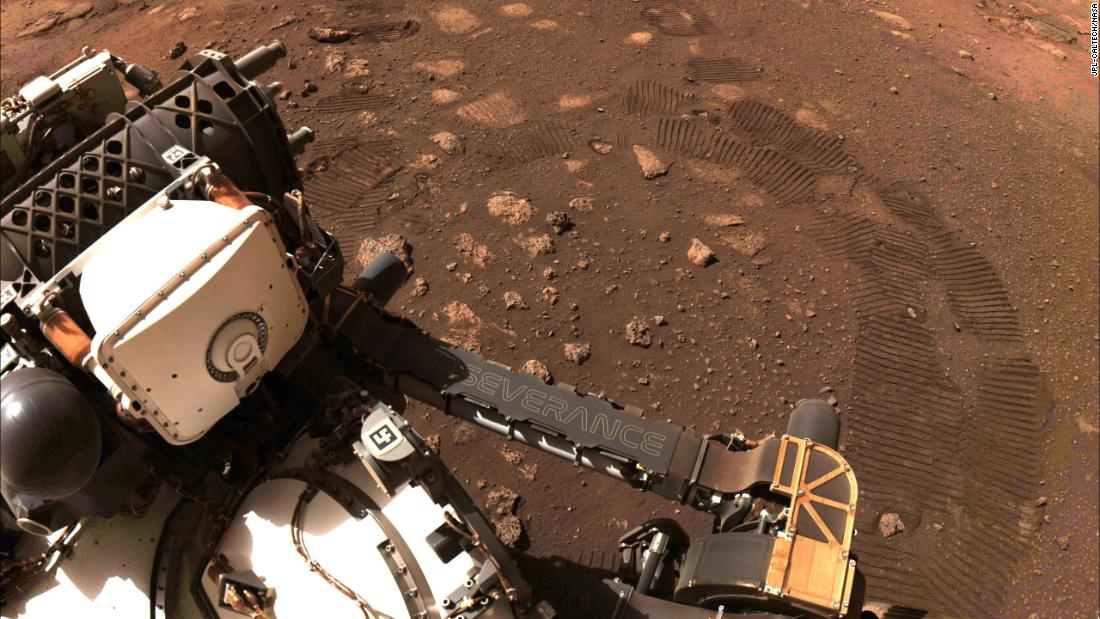Perseverance sent back images of its wheel marks on the red surface of Mars on Friday.
This is the first of many checkouts and milestones for the rover after its successful landing on February 18. As soon as the mission really begins to explore Mars, it will travel on an average of 656 feet or more.
“When it comes to vehicles with wheels on other planets, there are few new events that compare to the first trip,” said Zarifian. “This was our first chance to ‘kick the tires’ and take Perseverance for a ride. The six-wheel drive of the rover responded excellently. Now we are confident that our traction system is ready to go, able to get us going. take wherever science takes us in the next two years. “
During the first move, the rover moved forward 13 feet, turned 150 degrees to the left and reversed 8 feet. The rover was able to direct its cameras to where it landed.
Other images sent from the rover revealed more about the landing site, which the agency named Octavia E. Butler Landing in honor of the late science fiction author from Pasadena, California. The rover mission is managed by NASA’s Jet Propulsion Laboratory, located in Pasadena.
“Butler’s protagonists embody determination and creativity, making it perfect for the Perseverance rover’s mission and its theme of overcoming challenges,” said Katie Stack Morgan, assistant scientist for the rover project. “Butler inspired and influenced the planetary scientific community and many others, including those typically underrepresented in the STEM fields.”
Butler was the first African American woman to win the Hugo and Nebula awards. She was also the first science fiction writer honored with the MacArthur Fellowship.
“I can’t think of a better person to mark this historic landing site than Octavia E. Butler, who not only grew up alongside the JPL in Pasadena, but also inspired millions with his visions of a science-based future,” said Thomas Zurbuchen , associate administrator for NASA’s Science Mission Directorate, in a statement.
“Its guiding principle, ‘When using science, do it accurately’ is the goal of the NASA science team. Their work continues to inspire today’s scientists and engineers around the world – all in the name of a more bold and just future for all. “
A martian checkup
Perseverance is going through every move to check every aspect of the spacecraft’s health before it starts a journey through the Jezero crater in search of ancient life.
“Perseverance has done an exceptional job during its first two weeks on the red planet,” said Robert Hogg, deputy surface mission manager for the rover.
The rover received a software update that will help it explore Mars and has tested some of the onboard instruments, such as ground penetrating radar and its Mars In-Situ Oxygen Resource Experiment, or MOXIE instrument, which will convert the carbon dioxide from the planet into oxygen.
The rover also deployed two wind sensors in the Mars Environmental Dynamics Analyzer, or MEDA instrument, which is Perseverance’s personal weather station. The instrument is already sending meteorological data back to Earth.
Perseverance also flexed its 2.10-meter robotic arm, which carries instruments and cameras that will be used to investigate Mars.
“The first test of the robotic arm on Tuesday was a great moment for us,” said Hogg. “This is the main tool that the science team will use to take a close look at the geological features of the Jezero crater, and then we will drill and sample the ones that they find most interesting. When we have confirmation of the robotic arm flexing its muscles, including images of him working beautifully after his long trip to Mars – well, it made my day. “
More tests are scheduled for the rover in the coming weeks to evaluate the rest of its scientific instruments. Perseverance will also begin to explore longer drives.
In the spring, the rover will deposit the Ingenuity helicopter on the Martian surface so that it can prepare for test flights.
Perseverance has sent images back every step of the way, totaling about 7,000 since landing.
Once all of these checks are done and the helicopter has completed its test flights, Perseverance’s scientific mission will really begin.
Images captured by the rover are helping mission scientists plan the route for Perseverance as soon as it begins to explore. They saw intriguing rocks with different colors and textures, as well as different layers, something that scientists want to investigate more closely with the rover and its instruments. These layers can help reveal the previous Mars climate.
About a mile and a half away from the rover is a large mound, a rocky outcrop of layered rock deposited by rivers in a delta as they flowed into the ancient lake that once filled the Jezero crater 3.9 billion years ago, said Morgan .
Using images captured above the landing site by NASA orbiters around Mars, the science team is plotting several routes that the rover could take to explore these rocks and the outcrop even further. Then, scientists will have to make decisions about where to collect samples that will eventually be returned to Earth in future missions.
“We landed in a very interesting area where we are trying to discover the origin of these rocks: are they volcanic or are they sedimentary?” Morgan said. “From a sampling perspective and from a scientific perspective, we are interested in sampling the rocks in and around where the rover is now, as well as those that we will see along the way to the delta.”
